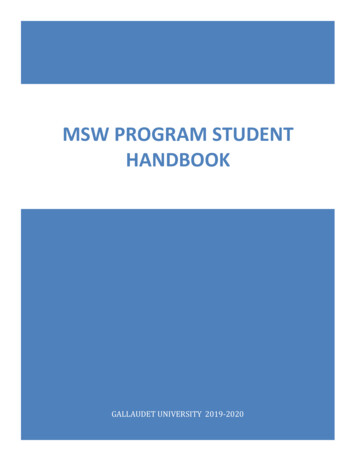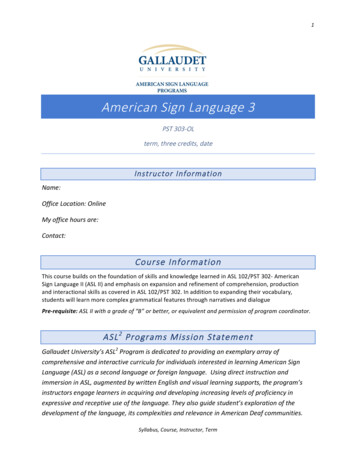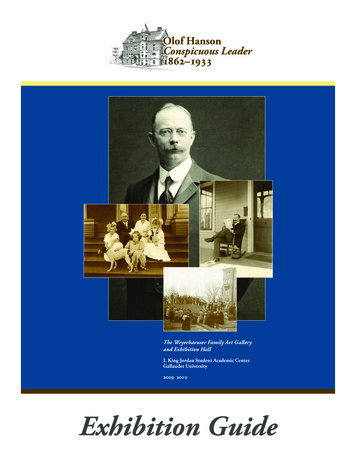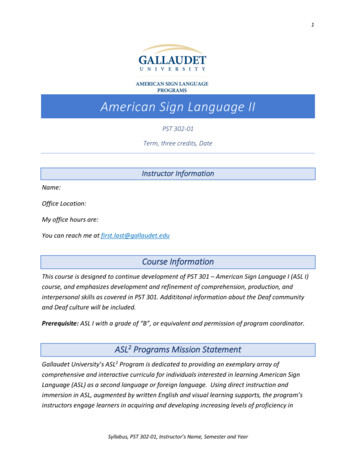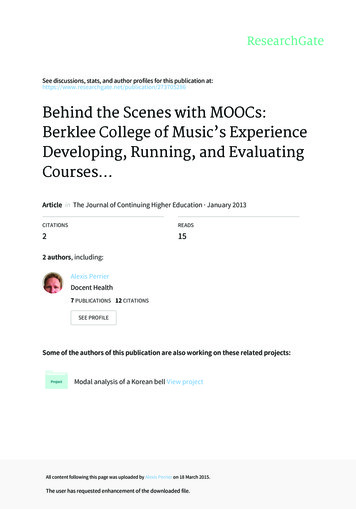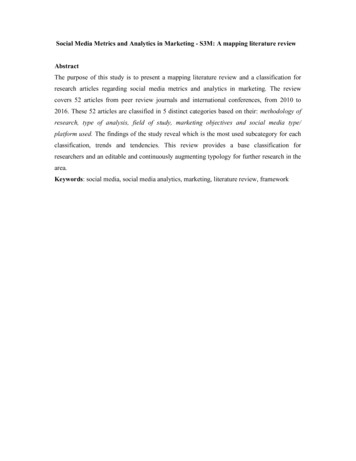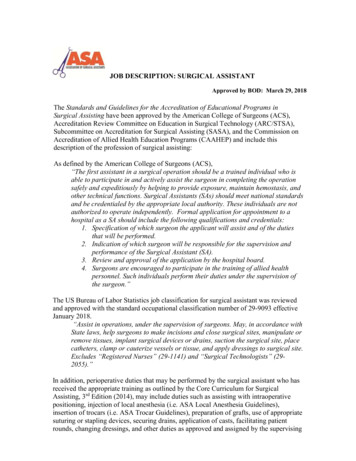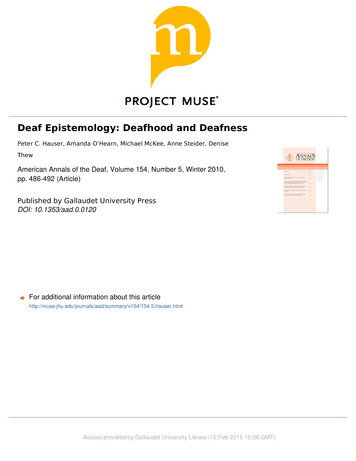
Transcription
'HDI (SLVWHPRORJ\ 'HDIKRRG DQG 'HDIQHVV3HWHU & DXVHU PDQGD 2 HDUQ 0LFKDHO 0F.HH QQH 6WHLGHU 'HQLVH7KHZAmerican Annals of the Deaf, Volume 154, Number 5, Winter 2010,pp. 486-492 (Article)3XEOLVKHG E\ *DOODXGHW 8QLYHUVLW\ 3UHVVDOI: 10.1353/aad.0.0120For additional information about this 54/154.5.hauser.htmlAccess provided by Gallaudet University Library (12 Feb 2015 15:06 GMT)
17665-AAD154.5 3/15/10 12:26 PM Page 486DEAF EPISTEMOLOGY: DEAFHOOD AND DEAFNESSDPETER C. HAUSER, AMANDAO’HEARN, MICHAEL MCKEE,ANNE STEIDER, ANDDENISE THEWHAUSER IS LABORATORY DIRECTOR, DEAF STUDIESLABORATORY, AND AN ASSOCIATE PROFESSOR,DEPARTMENT OF RESEARCH AND TEACHEREDUCATION, NATIONAL TECHNICAL INSTITUTE FORTHE DEAF, ROCHESTER INSTITUTE OF TECHNOLOGY(RIT), ROCHESTER, NY, AND NEUROCOGNITIVERESEARCH DIRECTOR, NSF SCIENCE OF LEARNINGCENTER ON VISUAL LANGUAGE AND VISUALLEARNING, GALLAUDET UNIVERSITY, WASHINGTON,DC. O’HEARN IS AN ASSISTANT PROFESSOR ANDCLINICAL PSYCHOLOGIST, DEAF WELLNESS CENTER,DEPARTMENT OF PSYCHIATRY, UNIVERSITY OFROCHESTER, ROCHESTER, NY, AND AN AFFILIATEDRESEARCHER, NATIONAL CENTER FOR DEAF HEALTHRESEARCH, DEPARTMENT OF COMMUNITY ANDPREVENTIVE MEDICINE, UNIVERSITY OF ROCHESTERMEDICAL CENTER (URMC). MCKEE IS A FELLOW,DEPARTMENT OF PREVENTIVE CARDIOLOGY,URMC, AND A PHYSICIAN, FAMILY MEDICINE CLINIC,LIFETIME HEALTH, ROCHESTER, NY. STEIDER ISA STAFF COUNSELOR, UNIVERSITY COUNSELINGCENTER, RIT, AND A CLINICAL ASSISTANTPROFESSOR, DEPARTMENT OF PSYCHIATRY, URMC.THEW IS A DOCTORAL STUDENT, COUNSELINGPSYCHOLOGY PROGRAM, UNIVERSITY OF NORTHDAKOTA, GRAND FORKS, AND A PSYCHOLOGYINTERN, DEAF WELLNESS CENTER, DEPARTMENTOF PSYCHIATRY, UNIVERSITY OF ROCHESTERE A F E P I S T E M O L O GY constitutes the nature and extent of the knowledge that deaf individuals acquire growing up in a society that reliesprimarily on audition to navigate life. Deafness creates beings who aremore visually oriented compared to their auditorily oriented peers.How hearing individuals interact with deaf individuals shapes how deafindividuals acquire knowledge and how they learn. Aspects of the Deafepisteme, not caused by deafness but by Deafhood, have a positive impact on how deaf individuals learn, resist audism, stay healthy, and navigate the world. Research on psychology, health, and education arereviewed to illustrate how visually oriented beings think and view theworld differently from the majority. The article provides support to thetheory of multiple epistemologies, and has implications for families,teachers, and researchers.How deaf1 people view themselves differs from how hearing people perceivethem. In Plato’s dialogue Theaetetus(trans. 2007), Socrates argued thatknowledge is a justified true belief.Contemporary social epistemologistsbelieve that how an individual justifiesa belief as “true” depends on that individual’s situation, surroundings, priorknowledge, and sociocultural influences. Feminist epistemologists addthat the individual’s body or biologyneeds to be taken into considerationwhen the nature of knowledge is discussed. Societies give individuals theknowledge of how to live in their bodies, how to show capacities unique toone’s sex, and how to experience theirbodies. Similarly, the way a society interacts with deaf infants, children, andadults has an impact on what thesedeaf individuals learn and know, andconsequently on their attitudes, interests, and values.The biological experience of a sensory deprivation and the socioculturalexperiences of others’ reactions and interactions illustrate the different effectsof deafness and Deafhood, respectively.The concept of Deafhood was intro-duced by Ladd (2003), who described itas something different from what isknown as Deaf culture. He suggestedthat Deafhood is “not a ‘static’ medicalcondition like ‘deafness’ . . . instead, itrepresents a process—the struggle byeach Deaf child, Deaf family, and Deafadult to explain to themselves and eachother their own existence in the world”(p. 3). Deafhood and deafness havestrong yet separate influences on thedeaf individual in and of themselves, aswe discuss below.From the biological viewpoint, deafness alone can enhance certain aspectsof an individual’s visual attention (seeBavelier, Dye, & Hauser, 2006, for a review). Specifically, deafness causes anindividual to allocate more attention tothe visual periphery and be more sensitive to motion on the periphery. Thiseffect might be due to deaf individuals’intrinsic need, for survival’s sake, torely on the visual modality more thanhearing individuals do. There are otherinfluences that are not effects of deafness but effects of competency in a visual language that enhance somecognitive functions (Bellugi et al.,1990; Emmorey & Kosslyn, 1996). The486VOLUME 154, NO. 5, 2010AMERICAN ANNALS OF THE DEAF
ne dd rO n eLife in a Visual RealitySome people place greater value onthe sense of audition, while othersplace more value on the sense of vision(Bahan, 2008). Many deaf parents celebrate and experience feelings of joywhen they find out that their newbornis deaf. This is not because of theirchild’s hearing loss, but rather their biological propensity to be more visuallyoriented. Deaf individuals have beenknown to seek partners based on theirchances of having a deaf child or havesought sperm donors who would increase their chances of having a deafchild. This practice has had an impacton legislation in England, where somehave expressed the view that deliberately attempting to create a deaf childis unethical and should be illegal(Bryan, Burke, & Emery, 2008). Somedeaf parents become depressed whenthey find out their child is hearing. Thegrieving process is similar to what hearing parents experience when they findout their child is deaf (Hauser, Wills, &Isquith, 2005; King, Hauser, & Isquith,2006).The knowledge that deaf individuals obtain about themselves and howthey should live their lives appears tovary depending on whether they areraised by deaf or hearing parents. Being around deaf adults appears to exert a positive influence on the schoolreadiness and learning of deaf children. Deaf children born to deaf parents who sign (henceforth referred toas Deaf of Deaf in the present article)achieve their (first) language development milestones at the same rate andtime as hearing individuals (Newport& Meier, 1985).Over 95% of all deaf individuals areborn into a family and a communitythat have no experience with howdeaf people learn and live, (such individuals are henceforth referred to asDeaf of Hearing in the present article). Parents typically socialize withtheir children intuitively in ways thatreflect how they assume their ownparents socialized with them. Fewhearing parents of deaf children cancommunicate effectively with theirdeaf child, and this seems to have animpact on language acquisition andsocial-cognitive development (Corina& Singleton, in press; Hauser, Lukomski, & Hillman, 2008).Studies have found that knowinghow to use nonverbal cues to directdeaf students’ attention is a factor thathas an impact on the students’ learning and is a skill taught by deaf parentsto deaf children (Smith & Ramsey,2004). Deaf of Deaf children begintheir schooling knowing where andwhen to look for visual information intheir environment. Crume and Singleton (2008) observed Deaf of Hearingchildren requiring more linguistic andphysical prompts to attend to theirteacher and classmates compared toDeaf of Deaf children. Deaf of Hearingchildren’s eye gaze behavior whenthey are in fourth grade lags behindthe eye gaze behavior of Deaf of Deafpreschool children (Ramsey & Padden, 1998).Hearing teachers seem to have difficulty taking over the parents’ task ofpreparing Deaf of Hearing childrenfor school or taking advantage of theskills that deaf parents pass on to theirdeaf children. For example, Erting(1988) observed a hearing teacherand a deaf teacher aide in a preschoolYearssimple notion of not being able to heardoes not completely define the deafindividual nor explain Deafhood.Deafness begets unique additional experiences for deaf individuals that gobeyond auditory sensory input. Byvirtue of their biology, deaf individualslive their lives in a visual reality, whichleads to the acquisition of a knowledge base that is different from that ofhearing individuals.t yix160a ndSHu17665-AAD154.5 3/15/10 12:26 PM Page 487classroom. The hearing teacher oftenbegan signing before all the childrenwere paying attention. In contrast, thedeaf teacher aide used visual and tactile signals to ensure that all childrenwere visually attending before shestarted to sign. Similarly, Mather (1989)investigated the eye gaze patterns of ahearing teacher and a deaf teacher andfound that only the deaf teacher managed to use eye gaze to direct the children’s attention to the person who wasspeaking. The hearing teacher used inappropriate eye gaze techniques thatconfused the students as to where tolook.Communication has always beenan area discussed in depth when itcomes to deaf pedagogy (Hauser &Marschark, 2008). In addition to natural signed languages, there are alsomany different visual communicationsystems made available to deaf children including speechreading, cuedEnglish, Signed English, and visualphonics. Many teachers of deaf children may not have ample time to develop their fluency and skill in anatural sign language or a visual communication system during their graduate training. When deaf children aretaught by individuals who are notproficient visual communicators, it isno surprise that these children donot learn at the same rate as hearingchildren (Bienvenu, 2008c). Deaf children do not have difficulty learning, asit is often assumed; rather, they arebeing raised and taught by adults whoare ill prepared to communicate withthem effectively.Glickman (2003) pointed out thatthe use of an interpreter provides anillusion of inclusion for deaf clientsreceiving mental health services.There is an illusion of inclusion in deafeducation as well, where the educators and parents believe that deaf children are achieving full access tolanguage. Many research studies show487VOLUME 154, NO. 5, 2010AMERICAN ANNALS OF THE DEAF
17665-AAD154.5 3/15/10 12:26 PM Page 488DEAFHOOD AND DEAFNESSotherwise. For example, both deafchildren and deaf adults typically understand less than 50% of what an individual says through speechreadingalone (Commission on Education ofthe Deaf, 1988). If a hearing adult usessign in addition to speech (Simultaneous Communication), deaf individualsagain typically still understand lessthan 50% of what is said (Tevenal &Villanueva, 2008). The situation is notmuch better when educational interpreters are used, as research hasshown that they interpret less than50% of what is said in the classroom(Schick, 2008).Today, individuals who are born reliant on vision for learning have the opportunity to acquire a natural signedlanguage. Yet medical and speech-language professionals often tell parentsnot to teach their deaf child a signedlanguage because it would impede thechild’s language development and independence—a claim that is not basedon empirical research (Marschark,2007). Almost all deaf education systems in the United States, if not all,place a greater value on the acquisitionof English than on the acquisition ofAmerican Sign Language (ASL). Furthermore, most schools for the deaf donot offer formal sign language classesas a part of the curriculum. Bienvenu(2008b) referred to the cultural valuation of one language over another as“linguisticism.” This neglect of sign language competency contrasts with theexperience of hearing students, whoundergo rigorous training and evaluation of their language skills in English.The valuation of auditorily based learning and languages over visual learningand languages apparently hinders deafstudents’ ability to learn.Incidental Learning andAccess to KnowledgeMany Deaf of Hearing children andadults are familiar with the dinnertable syndrome—they have experienced years at the dinner table watching close hearing family members andfriends converse with each other, butare unable to decipher what is beingsaid. Some deaf individuals also experience this at school if they attend amainstream program in which thereare few if any other deaf individuals.This is especially common during recess and lunchtime. When hearing individuals talk to each other withoutmaking their conversation accessibleto deaf individuals (whereas a hearingbystander would be able to follow theconversation easily), deaf individualsare deprived of incidental learning opportunities. An enormous amount ofincidental learning is lost to deaf individuals, while hearing children andadults have full access to this information. Deaf children who do not havefull access to everyday communication often do not see how adults express their thoughts and feelings, howthey negotiate disagreements, andhow they cope with stressors.This lack of access and reduction inincidental learning opportunities mayhave a negative impact on deaf individuals’ physical health (Mann, Zhou,McKee, & McDermott, 2007), mentalhealth (Hindley, Hill, McGuigan, &Kitson, 1994), and academic achievement (Traxler, 2000). For example, therates of presentation for injury inemergency room visits by deaf children have been found to be morethan twice those of hearing children,even after adjustments for age, race,sex, and the number of hospital oremergency department visits for treatment of non–injury-related conditions(Mann et al.). Parents typically verballypreinstruct or immediately warn children of dangers as they grow up, andchildren learn about risks and dangersby being directly instructed or by passively listening to the conversationsof others. The absence of incidentallearning about possible dangers maybe one cause of the higher rate of injury presentation visits, because deafchildren might not be aware of risksand dangers.In a further illustration of the relationship between improvised communication access and health, the lack ofincidental learning at home can alsohave a negative impact on deaf individuals’ knowledge of family history andhealth literacy. Health literacy is thedegree to which individuals have thecapacity to obtain, process, and understand basic health information and services needed to make appropriatehealth decisions. To get an idea of howthis process occurs, imagine a typicalThanksgiving gathering with severalfamily members conversing about family events that may have happenedover the past few months. An unclemay mention that he needs to be careful with his food choices since he wastold by his doctor that his cholesterolwas too high. A grandmother may respond that he needs to be careful sinceher deceased husband followed a poordiet and eventually succumbed to aheart attack at age 51. While such aconversation may be short, it will berich in details that likely will be missedby a deaf family member. The deaf individual is therefore less likely to benefitfrom aggressive screening proceduresor interventions since he or she cannotprovide a full family health history tohis or her physician.In one survey, 40.4% of deaf individuals were unable to identify a singlesymptom of heart attack (MargellosAnast, Estarziau, & Kaufman, 2006),something that 90% of hearing adultsin another survey were able to do (Geoff et al., 1998). Similarly, 62.6% of deafadults were not able to identify onesymptom of a stroke, while 70% ofhearing adults in another survey couldlist a symptom (Reeves, Hogan, & Rafferty, 2002). Communication barriers488VOLUME 154, NO. 5, 2010AMERICAN ANNALS OF THE DEAF
ne dd rO n eSteider (2001) found that secure attachments positively predicted greatercuriosity and health-enhancing behaviors in an adult sample of deaf individuals. Deaf adults have been reported tobe securely attached to other deafadults and insecurely attached to otherhearing adults (McKinnon, 1999). Because of communication difficulties,deaf children and their hearing parentsare more likely to have insecure relationships or attachments (Lederberg,1993). There also appears to be ahigher rate of abuse among deaf children (see Dobosh, 2002 for a review),and deaf adults have been found tohave more difficulty leaving abusive relationships than their hearing counterparts (Merkin & Smith, 1995).Living and growing up in a life inwhich one experiences the dinnertable syndrome at home and in schoolalso influences deaf individuals’ mental health. Foster (1989) pointed outthat many deaf adolescents experience the frustration and pain of isolation at home, in school, and in theneighborhood. A study conducted inthe United Kingdom found the prevalence of anxiety disorders to be ashigh as 50.3% among deaf childrenand adolescents, with greater prevalence among children in mainstreamed educational settings thanthose at schools for the deaf (Hindleyet al., 1994).Many deaf individuals struggle to acquire a positive identity or self-concept(Maxwell-McCaw, 2001). Consequently,many of them will not have an opportunity to develop the extensive selftheory that is necessary for a healthyidentity until they are exposed to deafrole models. Holcomb (1997) statedthat if one is to achieve a well-foundedself-theory, a common language is required for effective and meaningful interactions. A meta-analysis (Bat-Chava,1993) found three factors to be associated with better and healthier self-Yearsin the family not only have an impacton cardiovascular knowledge but onother areas of health as well. For example, Swartz (1993) found that 23% ofhearing individuals in a study samplelearned about sex primarily from theirmother, compared to only 2.9% ofdeaf individuals. Another study foundthat deaf college students engage inmore high-risk sexual behaviors andgenerally are not as well informedabout health and sexuality as theirhearing peers ( Joseph, Sawyer, &Desmond, 1996).Access to health knowledge is notthe only predictor of health-relatedbehaviors. Relationships (attachment)are generally accepted and viewed asan essential component of healthyemotional development in childrenand emotional maintenance in adults.Attachment style involves the willingness of the individual to explore his orher environment. Likewise, curiositycan be thought of as the interest of anindividual in seeking out new information from his or her environment.People with secure attachment stylesare likely to incorporate more interestin the environment, as the individualfeels secure in exploring, knowingthere is a safe base to which he or shecan return. Those with insecure attachment styles are likely to be lessinterested in seeking out new information, as the inherent risk-taking involved in curiosity would be increaseddue to the lack of a feeling of safety.Thus, the cognitive resources are notavailable to be curious about the environment and to seek out new information. Secure attachment styles arerelated to an increase in health-enhancing behaviors, and, conversely,insecure attachment styles are linkedwith participation in fewer health-enhancing behaviors. Attachment stylealso has been shown to predict anxiety and depression (Feeney & Ryan,1994).t yix160a ndSHu17665-AAD154.5 3/15/10 12:26 PM Page 489esteem among deaf children and adolescents: (a) parents who have a positive attitude toward deafness; (b) theavailability of clear and accessible communication within the home; and (c)identification with others within theDeaf community on the part of thedeaf child or adolescent and possession of a rich sense of language andheritage as a member of a vital culturalgroup.The impact of Deaf cultural pride isnot surprising given that hearing minority individuals who identify withtheir minority group have higher selfesteem than those who do not. Deafchildren seem to be taught at homeand at school that their aim should beto become more like hearing peopleand to repress or inhibit any characteristic that comes naturally to deafindividuals. Deaf individuals wholearn this false knowledge can still beliberated with the realization that theyare OK. This is the realization of whothey really are. It takes some unlearning of false knowledge and reconnecting the dots.Audism and Cultural CapitalAudism remains a relatively new topic,even though it was first mentioned inthe literature more than 30 years ago inan attempt to understand why visuallyoriented learners struggle to read English (Humphries, 1977; Humphries,Martin, & Coye, 1978). Humphries andcolleagues (1978) wrote:We believe that there are misunderstandings between the deaf andhearing cultures that have blockedthe kind of attitude and motivationnecessary for any learning, especiallylanguage learning, to happen. . . . Wefeel there is difference in the valuethat each culture places on Englishand ASL as a communication systemand as a survival tool. We feel thatdeaf people’s attitudes about them-489VOLUME 154, NO. 5, 2010AMERICAN ANNALS OF THE DEAF
17665-AAD154.5 3/15/10 12:26 PM Page 490DEAFHOOD AND DEAFNESSselves, their self-images, are often sopoor that they have contributed towhat we see as a “failure syndrome”around the deaf persons’ learning ofEnglish. . . . We feel that the problemis related to the interaction betweenthese cultures, not to some innate inability in the deaf person to learnEnglish, not to the deafness per se.(p. 12)Audism begins with a specific theoryof humanness. For example, bodiesthat hear normally are the prototypical human bodies. In audism, thebody is a starting point for social classification. The perception that there isa difference based on the body (i.e.,the perceived imperfection of deafbodies) is a concept common to audism, racism, and sexism (Humphries,2008). This perception leads to the assumption that deaf bodies are unwanted, inferior, and subject to repair.To the extent that deaf people do nothear and do not speak, they are seenas less intelligent, less capable, andless human (Bauman, 2004). Embedded within cultural practices andcoded into social and cultural institutions, audism often appears in theform of treatments, therapies, and interventions connected to a psychology of deficit (Lane, 1992). Economiceffects (workplace discrimination, classstruggle, undereducation, and underutilization) are a legacy of audism inGreat Britain as well as the UnitedStates (Turner, 2007). Yet perhaps themost salient impact of audism today isthat identities have been brought intoquestion among deaf people. Thestruggle of deaf people to maintain asense of identity in the face of others’definition of them has created uncertainty among deaf people about theirown linguistic, cultural, and socialidentities. Thus, a final defining characteristic of audism is that people areturned against themselves as they in-ternalize this dominating ideology ofothers (Humphries, 2008).African American mothers helptheir hearing (Pinderhuges, 1995) anddeaf (Borum, 2007) children developresiliency, resistance, or tolerance inthe face of racism. It is not clear howmuch deaf children learn about resisting or coping with audism from theirhearing parents. Resilience is the ability to thrive under adversity and is astrong predictor of recovery from difficult situations. Thew (2007) foundthat deaf employees working in hearing environments who attended aschool for the deaf have stronger resilience abilities than students who attended mainstream programs with orwithout support services. Deaf individuals appear to provide youngerdeaf individuals resistant capital tohelp them cope with audism and navigate an auditorily oriented world.The need for resistant and navigational capital is not limited to deafsigners but is also relevant to oral individuals, hard of hearing individuals,and individuals who use cochlear implants, as they all are subject to stereotyping and audism.Additionally, deaf individuals donot have as much access to the knowledge or cultural capital of the hearingcommunity, just as people of color donot have as much access to White cultural capital (see Yosso, 2005, on cultural capital). Deaf individuals born tohearing parents often do not have access to their parents’ capital as muchas their hearing peers have access totheir parents’ capital. Even with access, the capital that a deaf childmight receive from parents wouldteach that child how to live in theworld as a hearing individual or a lessthan individual, not as a visually oriented individual. Regardless of howhearing individuals try to mold deafindividuals into hearing deaf individuals, deaf individuals remain intuitivelydifferent. A parallel experience is assumed to occur among gay, lesbian,bisexual, or transgender children whoare raised by heterosexual parentsand taught by heterosexual teachers(Bienvenu, 2008a). With relevance toDeaf epistemology, the individual’sepisteme, or personal paradigm oflife, is shaped by the effects of his orher life and body.ConclusionSociety is made up primarily of hearing individuals who define how deafpeople are to live, express or inhibittheir capabilities, and experience theirbodies. If deaf individuals want to experience life as deaf individuals or visually oriented beings, this means theymust diverge from the hearing ideology. In this line of thought, audism isthe imposition of hearing ideology ondeaf individuals. Deaf epistemologycannot be comprehended without therecognition of the pervasiveness of audism and the impact it has on deaf individuals. Deaf epistemology shouldbe the lens through which auditorylearners seek to expand their understanding of visual learners, in order, ultimately, to enhance learning andstrive to create environments thatvalue visual beings as much as auditory beings—environments that, inother words, embrace Deafhood anddeafness as much as they embracehearinghood and hearingness.We recognize that most hearingparents only begin learning aboutdeafness and Deafhood after theyhave learned that their child is deaf.Anytime there is a sense of unfamiliarity about their child, parents mayrespond with fear or uncertainty.Hearing parents with a new deaf childare seeking reassurance and guidancefrom the educational and medicalcommunities. If the focus on deafnessis negative, the parents will have asense of guilt that their child is abnor-490VOLUME 154, NO. 5, 2010AMERICAN ANNALS OF THE DEAF
ne dd rO n eindividuals as important players (e.g.,advisers or role models) in the molding of deaf children, hearing parentsand teachers can learn some of the indigenous knowledge and experiencesthat deaf individuals share. If deaf individuals are recognized as full membersof society, inroads can finally be madetoward reducing some of the educational and health disparities they struggle with in a hearing-dominant society.AcknowledgmentsThe work for the present article waspartially funded by National ScienceFoundation Grant No. SBE-0541953and National Institutes of Health GrantNo. NCDCD RO1 DC004418–06A1 toPeter Hauser; Centers for DiseaseControl and Prevention Grant No. 1U48-DP-000031 and U.S. Departmentof Education Grant No. NIDRRH133A031105 to Amanda O’Hearn;and National Institutes of HealthGrant No. NHLBI 5-T32-HL-007937 toMichael McKee.Special thanks to Dr. Kim Dodge,Karen Finch, Dr. Shilpa Hanumantha,Tara Hillman, Jason Listman, and Dr.Jennifer Lukomski for reviewing earlierdrafts of this manuscript, and to Dr.Tom Humphries for sharing his description of the definition of audism.Note1. Deaf is defined more broadly thanusual here, but with some limits. Ingeneral, we are referring to individuals who have been deaf or hard ofhearing all or most of their lives andfor whom auditory channels are notsufficient for meaningful, accessiblecommunication. Much of the discussion might not be relevant to thosewho have not been deaf or hard ofhearing all of their lives or those withmild hearing loss. Also, much of whatis discussed here is specifically relevant to visually oriented communitiesthat have strong social networks ofYearsmal or even view their child as a failure, which allows audism to begin.Deafness should then be viewed inregard to the entire scope of the individual, not merely as a medical condition. A focus not on the deficit but onthe difference (e.g., visual orientationvs. auditory orientation) would likelyresult in better outcomes. Throughfailure to acknowledge the Deaf episteme, important strategies to achievea healthy educational and social environment for the deaf child may be ignored or lost. The overall intentionsof educational and medical professionals should be focused on the promotion of a healthy, well-adjusteddeaf child rather than on correction ofthe audition (which, historically, hashad mixed results at best in the promotion of the health and well-being ofdeaf people). Educational and medical professionals, as well as the family,must concern themselves with thechild’s strengths if the child is toachieve full potential. With greaterawareness of Deaf epistemology, abetter collaboration among the different communities—medical, educational, and social—can occur, allowinghearing parents to be fully informedabout how best to raise their deafchild. Through acknowledgment thatsociety is heterogeneous, each member is valued, and there is no one stylethat fits all, the wall of audism can beslowly torn down.Through research in education,health, and science, a joint efforttoward a natural visual-learning environment that will be amenable to thedeaf child’s learning processes can beachieved. This is possible if researchersremove their biases of hearing ideology, realize that there are multipleepistemologies, and study how deaf individuals truly develop and navigatethe world as well as the indigenousknowledge passed on to deaf childrenby deaf adults. By incorporating deaft yix160a ndSHu17665-AAD154.5 3/15/10 12:26 PM Page 491deaf peers and other individuals fluent in a visual language.ReferencesBahan, B. (2008). Upon the formation of a visual variety of the human race. In H. D. L.Bauman (Ed.),
center, rit, and a clinical assistant professor, department of psychiatry, urmc. thew is a doctoral student, counseling psychology program, university of north dakota, grand forks, and a psychology intern, deaf wellness center, department of psychiatry, university of rochester d 17665-aad154.5 3/15/10 12:26 pm page 486

